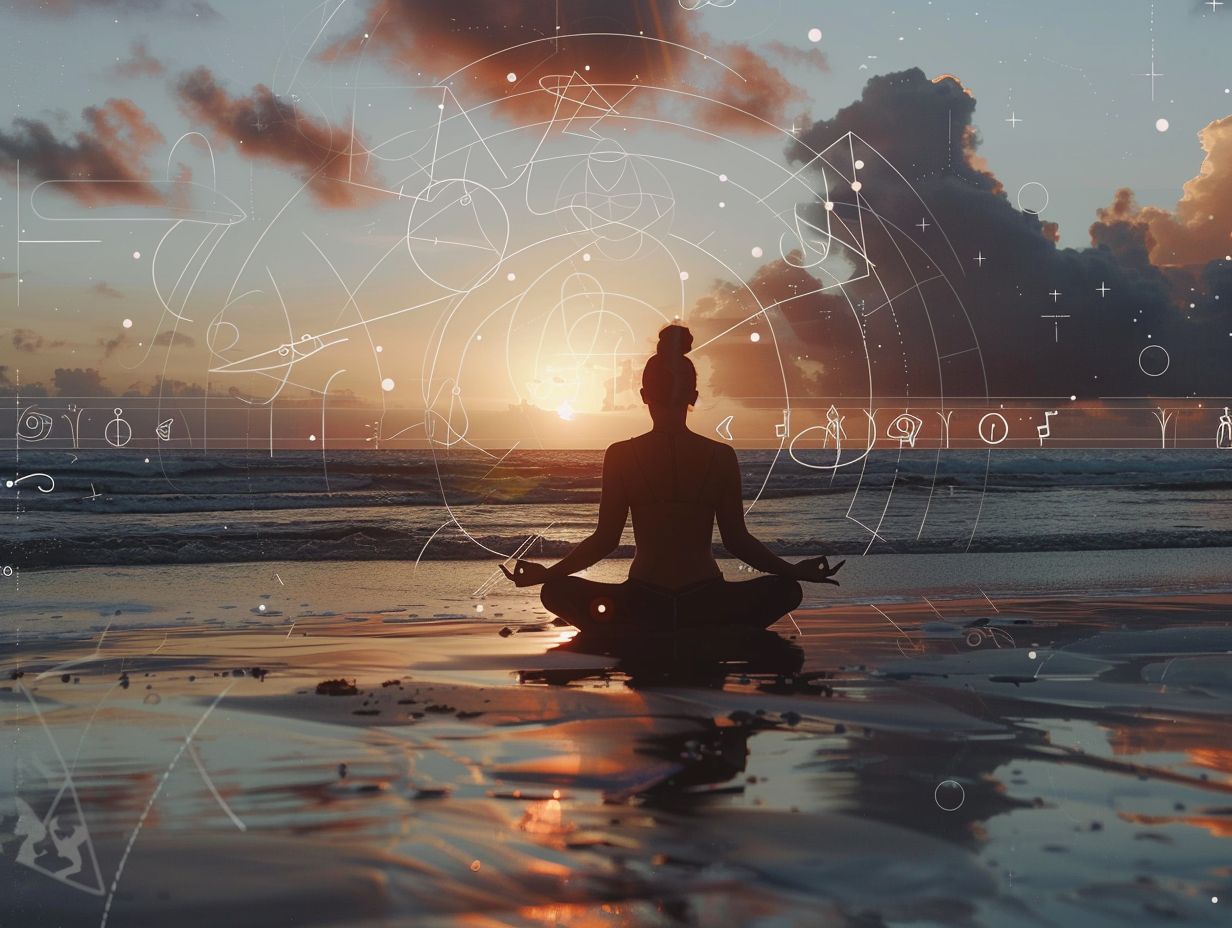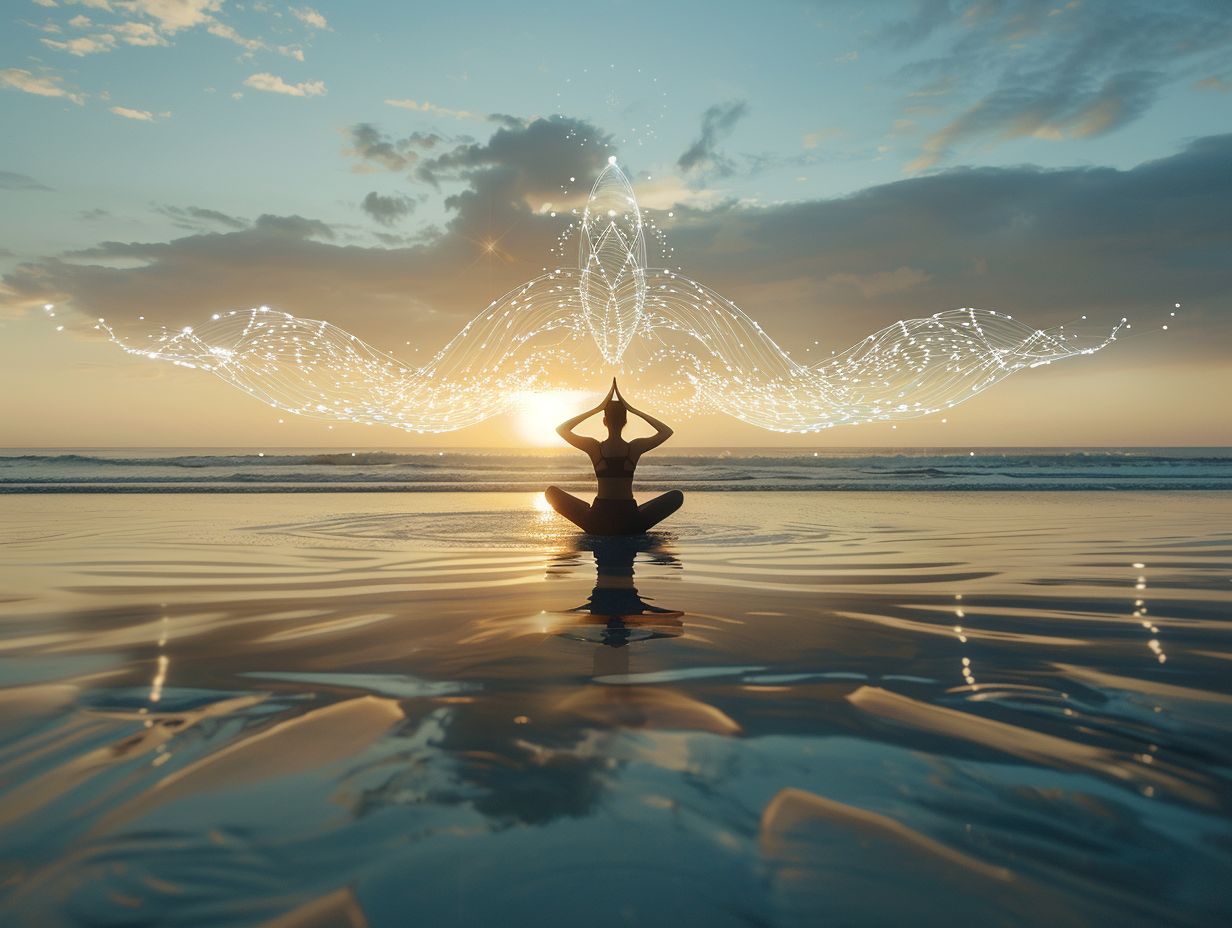Integrating Yoga and Samkhya Philosophy
Yoga and Samkhya philosophy represent ancient practices that delve into the intricacies of existence and the enhancement of personal well-being. While yoga is frequently linked to physical postures and relaxation techniques, Samkhya philosophy offers a comprehensive framework for comprehending the dualities of life, exemplified by the concepts of Purusha and Prakriti.
This exploration seeks to illuminate how these two disciplines can be harmoniously integrated, showcasing their collective advantages for physical health, mental clarity, and spiritual growth.
Readers are invited to engage in a thoughtful examination of the principles, practices, and prevalent misconceptions surrounding this integration, fostering a deeper understanding of their combined potential.
What Is Yoga?

Yoga represents a sophisticated practice that transcends the boundaries of conventional physical exercise. It embodies a harmonious fusion of physical postures, mindfulness, and spiritual growth, all directed toward the attainment of inner peace and self-realization.
Grounded in ancient wisdom, the philosophy of Yoga advocates for the integration of body and mind, cultivating a profound connection to the self. This is achieved through techniques such as meditation, breath control (Pranayama), and ethical principles articulated in the Yoga Sutras.
The practice enhances not only physical health but also psychological insight, thereby contributing to holistic well-being and personal transformation.
What Is Samkhya Philosophy?
Samkhya Philosophy represents an ancient Indian philosophical system that articulates the dualistic nature of existence through the concepts of Purusha (consciousness) and Prakriti (matter). This philosophy serves as a guiding beacon for individuals seeking liberation and self-understanding.
It presents a comprehensive framework for grasping the intricacies of reality, existence, and consciousness, highlighting the dynamic interplay between these fundamental entities. Moreover, it delves into metaphysical concepts that continue to resonate within contemporary philosophical discourse.
Through its methodical approach, Samkhya offers profound insights into the human condition, the essence of suffering, and the various pathways to enlightenment.
How Can Yoga and Samkhya Philosophy Be Integrated?
The integration of Yoga and Samkhya Philosophy offers a profound framework for personal transformation, presenting pathways to self-realization through a nuanced understanding of the mind-body connection and the practice of ethical living. By harmonizing the physical and meditative dimensions of Yoga with the philosophical insights inherent in Samkhya, practitioners cultivate a holistic approach to spiritual growth that emphasizes non-attachment (Vairagya) and heightened self-awareness.
This synergistic relationship nurtures deeper introspection and invites individuals to explore their own consciousness, ultimately guiding them toward liberation and inner peace.
1. Understanding the Concept of Purusha and Prakriti
Understanding the concepts of Purusha and Prakriti is fundamental to grasping the dualistic framework of Samkhya Philosophy. In this context, Purusha signifies pure consciousness, while Prakriti embodies the material world. This dualism elucidates the relationship between the observer and the observed, positing that true knowledge emerges from recognizing the distinction between the eternal self (Purusha) and the transient nature of reality (Prakriti).
The interplay between these two elements not only establishes a foundation for intellectual comprehension but also serves as a vital tool for self-awareness and personal growth. In this regard, practitioners of Yoga can cultivate a deeper awareness of their internal states, distinguishing the ephemeral nature of emotions and thoughts arising from Prakriti, while simultaneously reconnecting with the unchanging essence of Purusha.
This dualistic understanding is essential for addressing the nature of suffering, as it encourages individuals to step back from identifying with their fleeting experiences, thereby fostering a heightened consciousness that transcends pain and attachment.
Ultimately, this journey into self-awareness illuminates pathways to liberation, enabling individuals to navigate life s challenges with greater ease and clarity.
2. Incorporating the Eight Limbs of Yoga
The Eight Limbs of Yoga, as articulated in the Yoga Sutras, offer a methodical framework for spiritual practice (Sadhana) that integrates ethical principles, physical postures (Asanas), breath control (Pranayama), and meditative states (Samadhi). These limbs serve as a thorough guide for practitioners aspiring to achieve a harmonious integration of body, mind, and spirit, ultimately guiding them towards self-realization and inner peace.
In grasping the essence of each limb, one fosters a profound connection with both Yoga and Samkhya Philosophy, which underscores the importance of comprehending the nature of reality and the distinction between the self (Purusha) and the material world (Prakriti). The initial two limbs, Yama and Niyama, lay the groundwork for ethical guidelines and self-discipline, essential for moral development.
Following these, Asanas enable practitioners to cultivate physical strength and flexibility, preparing the body for meditation and enhancing overall well-being. Concurrently, Pranayama highlights the vital link between breath and mental state, illustrating how mastery of breath can lead to heightened focus and emotional equilibrium.
Through the committed practice of these limbs, individuals can embark on a journey of significant spiritual growth, paving the way for deeper insights and a serene state of being.
3. Practicing Self-Inquiry and Self-Realization
Practicing self-inquiry stands as a cornerstone of both Yoga and Samkhya Philosophy, cultivating a profound sense of self-realization through the twin lenses of mindfulness and introspection. This practice invites individuals to delve into their thoughts, beliefs, and behaviors, thereby nurturing ethical living and facilitating personal transformation in the quest for inner understanding and harmony.
Through the process of self-inquiry, practitioners attain a heightened awareness of their emotional triggers and thought patterns, give the power toing them to make conscious choices that resonate with their true values. By engaging in regular reflection and questioning, individuals can dismantle the barriers that often obscure authentic self-awareness, paving the way for a richer connection to their inner essence.
The mindfulness developed during this journey not only enhances clarity and focus but also fosters compassion toward oneself and others, leading to healthier relationships and a deeper sense of community. Ultimately, self-inquiry emerges as a transformative tool, guiding individuals along their path to profound self-discovery and lasting fulfillment.
What Are the Benefits of Integrating Yoga and Samkhya Philosophy?

The integration of Yoga and Samkhya Philosophy presents a wealth of benefits that transcend mere physical health, enriching mental clarity, emotional equilibrium, and spiritual advancement.
Practitioners frequently report an enhancement in overall well-being, a decrease in stress levels, and a profound comprehension of their inner selves, fostering greater emotional resilience and inner tranquility.
This holistic approach cultivates a harmonious relationship between body and mind, paving the way for personal transformation and a profound sense of connectedness with the universe.
1. Improved Physical Health
Integrating Yoga and Samkhya Philosophy plays a pivotal role in enhancing physical health through the practice of Asanas and various Yoga techniques that optimize energy flow and overall vitality. Regular engagement in physical activity not only fortifies the body but also nurtures holistic well-being by recognizing the interconnectedness of physical, mental, and spiritual dimensions.
As individuals immerse themselves in specific Yoga practices, they often observe significant improvements in flexibility, which in turn allows for a broader range of motion in everyday activities. The focus on strength-building postures fosters muscular endurance, give the power toing the body to navigate physical challenges with remarkable ease.
This mindful movement enhances not only physical capabilities but also promotes a more efficient flow of energy throughout the body, thereby improving circulation and alleviating stress levels. By embracing these transformative practices, individuals can cultivate a harmonious balance that nourishes both body and mind, ultimately leading to enhanced vitality and a profound connection to their holistic health.
2. Mental Clarity and Emotional Balance
One of the profound benefits of integrating Yoga and Samkhya Philosophy lies in its ability to enhance mental clarity and emotional balance, achieved through dedicated mindfulness and meditation practices. These techniques cultivate self-awareness and promote emotional regulation, enabling individuals to navigate life’s challenges with greater resilience and composure.
By fostering a deeper understanding of their thoughts and feelings, practitioners can elevate their emotional intelligence, facilitating a calm and rational response to various situations. This heightened awareness translates into improved decision-making skills, as individuals learn to distinguish between impulsive reactions and thoughtful responses. As a result, consistent practice contributes to a reduction in stress and anxiety, creating a serene mental landscape where clarity flourishes.
As self-reflection becomes an integral part of their daily routines, individuals often experience an increase in focus, give the power toing them to approach tasks with renewed energy and a genuine sense of purpose.
3. Spiritual Growth and Self-Discovery
The journey of integrating Yoga and Samkhya Philosophy cultivates profound spiritual growth and self-discovery, inviting individuals to embark on an inward exploration that unveils deeper truths about themselves and their place within the universe. Through dedicated practices such as meditation and self-study, practitioners reveal layers of consciousness, thereby facilitating personal transformation and enriching their understanding of their spiritual journeys.
These practices transcend mere relaxation techniques; they serve as transformative tools that enable intense introspection and heightened self-awareness. As individuals delve deeper into their thoughts and emotions, they confront and dissolve limiting beliefs, thereby opening themselves to new perspectives.
Various techniques including mindful breathing, contemplation, and ethical living become essential allies in this exploration, guiding individuals toward a more harmonious existence. This holistic approach not only enhances personal insight but also aligns actions with higher principles, fostering a profound sense of purpose and connection to the greater cosmos.
How Can One Start Integrating Yoga and Samkhya Philosophy?
To effectively integrate Yoga and Samkhya Philosophy into one’s life, it is imperative to seek out a qualified teacher who can offer the necessary guidance and support in navigating these profound practices.
Engaging with esteemed Yoga texts and teachings, combined with a dedicated commitment to a regular practice (Sadhana), lays the groundwork for a meaningful assimilation of these philosophies into daily existence.
1. Finding a Qualified Teacher
Finding a qualified teacher is essential for successfully integrating Yoga and Samkhya Philosophy, as such an instructor can provide personalized guidance and create a supportive learning environment. An experienced teacher can aid practitioners in navigating the complexities of these disciplines, ensuring a practice that is both safe and effective.
A mentor in this journey does more than impart essential knowledge; they embody the qualities of empathy, patience, and effective communication. It is important to seek an instructor who possesses a robust foundation in both theoretical understanding and practical application, as this combination fosters deeper insights. A skilled teacher encourages students to delve into their own experiences, nurturing confidence through constructive feedback.
The benefits of such mentorship extend well beyond immediate learning; they also cultivate personal growth and forge a lifelong connection to these ancient philosophies. Through their expertise, practitioners can enhance their mindfulness and develop a more profound understanding of how to live harmoniously with these powerful teachings.
2. Studying the Texts and Teachings

Studying the foundational texts and teachings of Yoga and Samkhya is paramount for a comprehensive understanding of these intricate philosophies.
By immersing oneself in the Yoga Sutras of Patanjali and the Samkhya Karika, practitioners can unveil profound insights into the nature of existence, consciousness, and the journey toward liberation. These texts offer a robust framework for exploring the intricate relationship between the mind and body, along with the critical principles of dualism and non-dualism that are fundamental to personal evolution.
Through such exploration, individuals can cultivate a heightened awareness and discernment essential components of the path to self-realization. Engaging with these rich traditions not only stimulates philosophical inquiry but also invites a transformative experience, resonating deeply with the quest for inner peace and understanding in an ever-accelerating world.
3. Incorporating the Practices into Daily Life
Incorporating the practices of Yoga and Samkhya Philosophy into daily life represents a transformative journey that nurtures mindfulness and enhances overall well-being. Through a commitment to regular Sadhana, individuals can establish routines that foster mental clarity, emotional equilibrium, and spiritual development.
This integration may commence with simple yet profound gestures, such as dedicating a few moments each morning to mindful breathing or engaging in gentle stretches that invite awareness into the body. Mindfulness can effortlessly permeate daily activities be it practicing gratitude during meals, cultivating presence through mindful walking, or taking pauses to meditate amidst a hectic day.
By prioritizing these dedication-driven practices, individuals can gradually forge a deeper connection with themselves and the world around them, ultimately transforming ordinary moments into opportunities for joy and reflection.
What Are Some Common Misconceptions About Integrating Yoga and Samkhya Philosophy?
Despite the rising prominence of Yoga and Samkhya Philosophy, a number of prevalent misconceptions continue to obstruct individuals from fully engaging with these transformative practices.
There exists a common belief that Yoga is merely a form of physical exercise, while many perceive Samkhya Philosophy as reserved exclusively for intellectuals.
Additionally, some individuals harbor concerns that incorporating these practices might conflict with their religious beliefs. Addressing these misconceptions is essential for cultivating a deeper understanding and appreciation of the holistic essence of these philosophies.
1. Yoga is Only About Physical Exercise
A prevalent misconception persists that Yoga is merely a form of physical exercise, fixating solely on Asanas while overlooking its profound philosophical foundations. In truth, Yoga represents a holistic approach that intertwines meditation, mindfulness, and ethical principles, all contributing to an individual s overall mental and spiritual well-being.
This ancient practice transcends the confines of the mat, intricately weaving together essential elements such as breath control, or Pranayama, alongside self-discipline through Yama and Niyama. These guiding principles direct practitioners toward a more balanced and fulfilling life.
The journey of Yoga invites individuals to cultivate awareness, fostering a deep connection among body, mind, and spirit. By integrating these dimensions, Yoga give the power tos practitioners to delve into their inner selves, unlocking pathways to personal growth and enlightenment.
With its rich tapestry of theories and practices, Yoga provides enduring insights that resonate across diverse cultures, showcasing its transformative potential for anyone willing to engage with it.
2. Samkhya Philosophy is Only for Intellectuals
A prevalent misconception is that Samkhya Philosophy is solely the domain of intellectuals or scholars, which often dissuades many individuals from diving into its teachings. In reality, Samkhya Philosophy presents practical applications that are accessible to everyone, offering profound insights into the nature of reality and personal growth that can enrich all practitioners.
This ancient philosophical system promotes self-reflection and critical thinking, ensuring its relevance even in contemporary contexts. By grasping its principles, individuals can navigate life’s complexities with enhanced clarity and ease. It imparts the ability to discern between the transient and the eternal, fostering a sense of give the power toment as one learns to manage emotional turbulence and cultivate resilience.
Moreover, the philosophical framework of Samkhya can serve as a solid foundation for mindfulness practices, elevating one s daily experiences and relationships. Ultimately, embracing this philosophy encourages a harmonious approach to life that integrates mind, body, and spirit, paving the way for greater fulfillment and purpose.
3. Integrating Yoga and Samkhya Goes Against Religious Beliefs
Many individuals perceive the integration of Yoga and Samkhya Philosophy as potentially conflicting with their religious beliefs, leading to a hesitance in delving deeper into these practices. However, both Yoga and Samkhya emphasize universal principles that can complement a variety of spiritual paths rather than contradict them.
By concentrating on the foundational concepts of mindfulness, balance, and self-realization, these philosophies provide insights that resonate with a broad audience, transcending cultural and religious boundaries. For example, the notion of self-inquiry in Samkhya can enhance one s understanding of spiritual narratives present in various faiths. Similarly, Yoga’s focus on breathing and meditation serves as a bridge for individuals from diverse backgrounds, fostering a sense of community.
This synthesis encourages practitioners to embrace their unique beliefs while simultaneously discovering common ground with others, ultimately enriching their spiritual journeys and cultivating a more inclusive approach to personal growth.
Frequently Asked Questions

What is the relationship between Yoga and Samkhya Philosophy?
Yoga and Samkhya Philosophy are two ancient Indian philosophical systems that have a strong connection. Yoga draws heavily from the concepts and principles of Samkhya Philosophy, and both aim to attain spiritual liberation and self-realization.
How does Yoga connect with Samkhya Philosophy?
Yoga integrates with Samkhya Philosophy by incorporating its key principles, such as the concept of purusha (consciousness) and prakriti (matter), into its practices. Yoga also utilizes Samkhya’s concept of the gunas (qualities) to understand and balance the mind and body.
What are the benefits of integrating Yoga and Samkhya Philosophy?
The integration of Yoga and Samkhya Philosophy offers numerous benefits, including a deeper understanding of the self and the universe, improved physical and mental health, and a path towards spiritual enlightenment and inner peace.
Can anyone integrate Yoga and Samkhya Philosophy into their practice?
Yes, anyone can integrate Yoga and Samkhya Philosophy into their practice, regardless of their age, physical ability, or religious beliefs. Both systems are flexible and can be adapted to suit individual needs and preferences.
Do you need prior knowledge of Samkhya Philosophy to practice Yoga?
No, prior knowledge of Samkhya Philosophy is not necessary to practice Yoga. However, understanding the underlying principles and concepts can enhance one’s practice and deepen their understanding of the mind-body connection.
Is it necessary to follow a specific path or tradition to integrate Yoga and Samkhya Philosophy?
No, there is no specific path or tradition that must be followed to integrate Yoga and Samkhya Philosophy. Both systems offer a variety of practices and techniques that can be tailored to an individual’s needs and goals.
